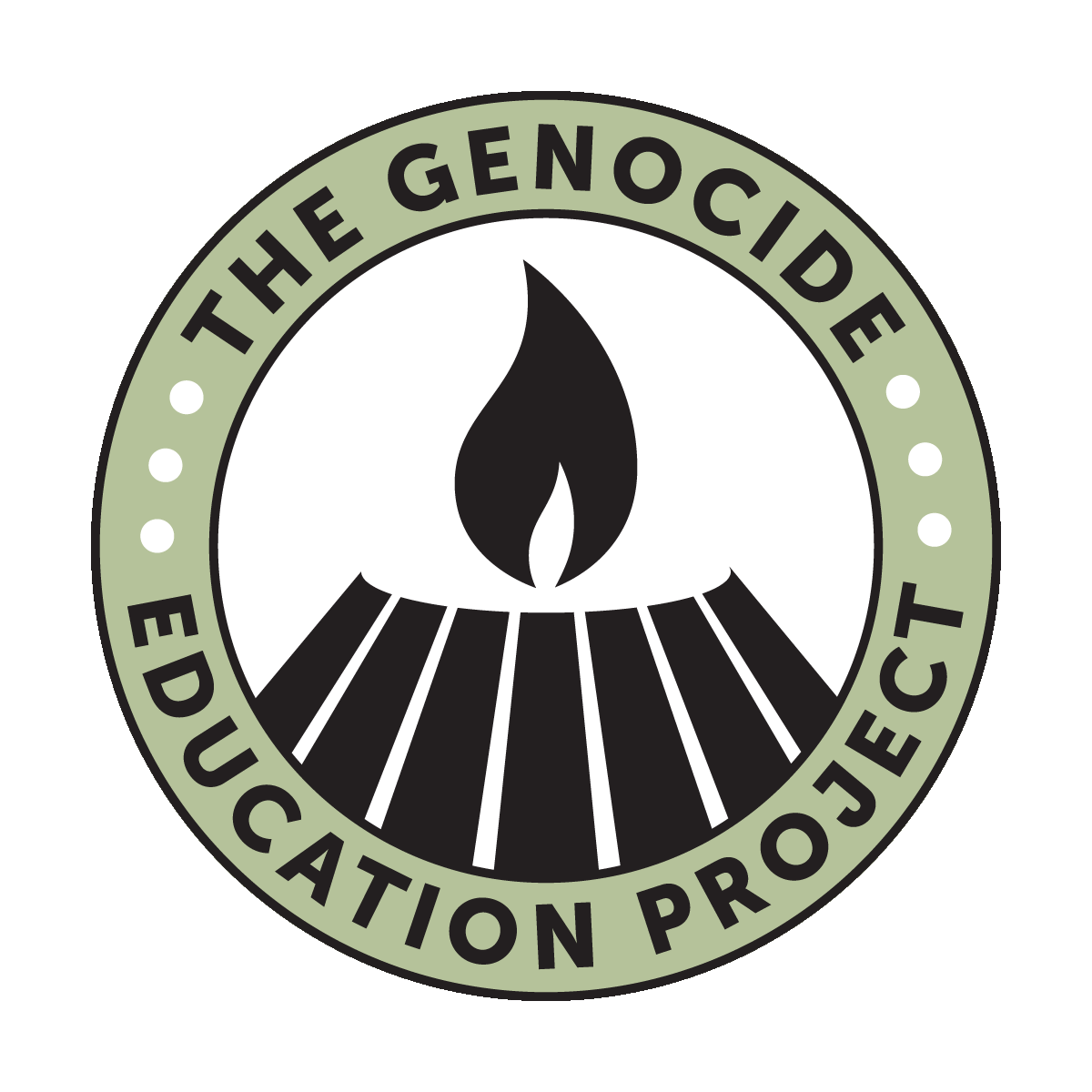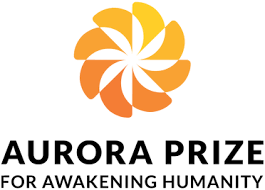News |
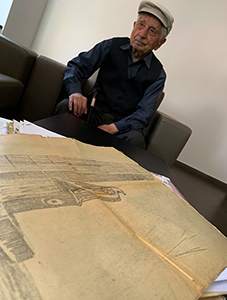
Sergey Teryan
On the occasion of his 100th birthday
12.04.2024
Today marks Sergey Teryan’s 100th birthday. An Armenian inventor and technical sciences candidate, he was born in the village of Banants (in the Gardman county of Utik province of historical Greater Armenia, now in Azerbaijan). He dedicated his entire life to raising the issues of his native world of Gardman and its people.
Some years ago Sergey Teryan handed over, from his personal archive, his handwritten memoir and exclusive archival materials concerning the construction of the “Artsiv” (Eagle) fountain-monument dedicated to the memory of the victims of the Patriotic War in the village of Banants and the story of its destruction overnight by the Azerbaijani authorities, comprising photos, documents, manuscripts. etc. to the Armenian Genocide Museum-Institute.
Sergey Teryan was chairman of the organising committee for the monument’s and the architect was Rafael Israelyan. Unfortunately, the official opening of the monument never took place as the Baku authorities, stating that it symbolised General Andranik, labeled the monument in the form of an eagle as "Dashnak" (ARF) and, on the night of July 26, 1969, having turned the village and surrounding area lights off beforehand, demolished the memorial.
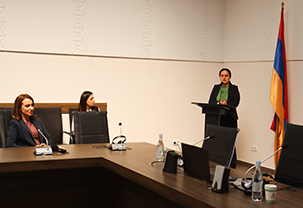
PARTICIPANTS OF THE “ROOT AND SPROUT” COMPETITION AT THE AGMI
10.04.2024
The presentation-discussion of the work of three participants of last year’s “Root and Sprout” creative competition took place in the AGMI conference hall on April 6. Edita Gzoyan, Director of the AGMI, made a speech of welcome, in which she greatly appreciated the students’ work and encouraged them to do more in-depth research in the future.
Inessa Stepanyan, responsible for AGMI educational programmes, Ani Manukyan, author and organiser of the “Root and Sprout” creative competition and Tehmine Martoyan, AGMI senior researcher, all made speeches.
Students and teachers from different schools participated in the event. The first work was presented by Serin Agapi Sipan, an “Anania Shirakatsi” international scientific and educational complex student, who was awarded the “Best work” nomination last year and received the Suren Hanesyan prize.
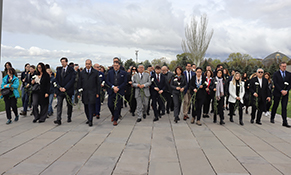
President of the Bouches-du-Rhône Department and Aix-Marseille-Provence Metropolis Martin Vassal visited the Armenian Genocide Memorial
10.04.2024
The delegation led by the President of the Bouches-du-Rhône Department and Aix-Marseille-Provence Metropolis, Martin Vassal, visited the Armenian Genocide Memorial, on April 10, accompanied by the Extraordinary and Plenipotentiary Ambassador of France to Armenia, Olivier Decottignies.
Director of the Armenian Genocide Museum-Institute Edita Gzoyan welcomed the guests and accompanied them to the Armenian Genocide Memorial.
Mrs. Martin Vassal laid a wreath at the memorial complex, after which the accompanying guests put flowers at the Eternal Fire and observed a minute’s silence in memory of the innocent martyrs of the Armenian Genocide.
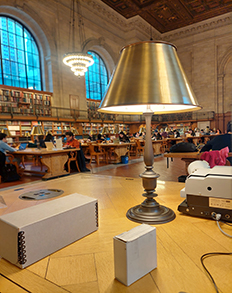
FOREIGN ARCHIVES ARE THE FOCUS OF ATTENTION AT THE AGMI
09.04.2024
The Armenian Genocide Museum-Institute has, in recent months, initiated studies of large and small archives in different countries in order to make scientific research more active.
AGMI researchers Regina Galustyan, Anna Kazaryan and Shushan Khachatryan visited the capital of Georgia, Tbilisi, in December 2023, with Regina Galustyan and Anna Kazaryan making a return visit there in March 2024. They went to study Armenian documents stored in the National Archives of Tbilisi and the National Parliamentary Library of Georgia. These related to to the settling of Armenian refugees and orphans in various places in the Caucasus after the Armenian Genocide and the activities of humanitarian organizations. They also examined documents concerning the foreign policy of the viceroyalty of the Caucasus relating to the Armenians as well as Russian-language newspapers published in Baku in 1914-1918, copies of which are unavailable in the Republic of Armenia and which may have references to episodes of the Armenian Genocide.
Narek Poghosyan, an AGMI researcher, was sent to New York in March 2024 to study the archive collection belonging to lawyer Raphael Lemkin, who coined the term “genocide”, which is held in the main branch of the New York Public Library in Manhattan.
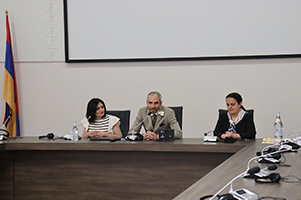
LIDICE INTERNATIONAL CHILDREN'S FINE ART EXHIBITION AWARD CEREMONY AT THE AGMI
06.04.2024
According to the beautiful tradition already established, the award ceremony for Armenian participants in the 51st Lidice International Children's Fine Art Exhibition was held in the Armenian Genocide Museum-Institute on April 4. This year the international exhibition was titled “Dance”.
Edita Gzoyan, Director of the Armenian Genocide Museum-Institute, welcomed the participants and attendees to the exhibition, saying, “I am glad to welcome you and be your host at the Armenian Genocide Museum-Institute. This beautiful event is a unique tribute to the memory of the innocent children killed by the German Nazis in the Czech village of Lidice, as well as to the memory of the innocent children killed by the Turks during the Armenian Genocide. It is no coincidence that the conclusion of the competition takes place in the Armenian Genocide Museum-Institute.”
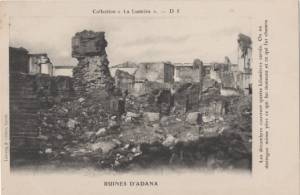
ADANA 1909: 115 YEARS AFTER THE ARMENIAN HOLOCAUST
04.04.2024
The massacres that took place in the Adana and Aleppo provinces in April 1909 were the second stage of the organised massacres and mass killings of Armenians in the Ottoman Empire. It appeared in the city of Adana and the surrounding areas in all its inhumanity and brutality and happened several months after the Young Turk coup, coinciding with a counter-revolution carried out by supporters of Sultan Abdul Hamid II. The Adana massacres clearly showed that, in this sense and despite the change of Turkish regimes and mutual internal disagreements, the policies adopted to solve the Armenian question and dealing with Armenians remained unchanged.
The Adana massacres began on April 1, when a previously prepared and armed Turkish mob rushed into the city's streets, squares, and neighbourhoods and began massacring Armenians. The first wave of massacres lasted for three days. They resumed on April 12, continuing for a further two days. The Turkish army, although it allegedly arrived at that time to “restore order and the rule of law” also participated in the massacres alongside the mob.
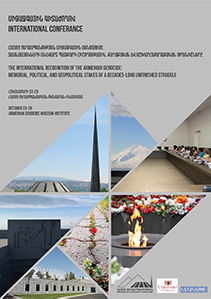
INTERNATIONAL CONFERENCE
The International Recognition of the Armenian Genocide: Memorial, Political, and Geopolitical Stakes of a Decades-Long Unfinished Struggle
30.03.2024
The conference will take place on October 23-25, 2024, at the Armenian Genocide Museum-Institute, Yerevan, Armenia.
The conference is organized jointly by the Armenian Genocide Museum-Institute Foundation and the Laboratoire MIMMOC (Mémoires, Identités, Marginalités dans le Monde Occidental Contemporain) of the University of Poitiers, France.
The conference announcement is attached.
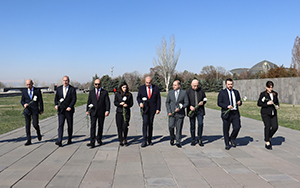
Chairman of the Education, Science and Youth Affairs Committee of Parliament of Georgia Givi Mikanadze, visited the Armenian Genocide Memorial
28.03.2024
The delegation led by the Chairman of the Committee on Education, Science and Youth Affairs of the Parliament of Georgia, Givi Mikanadze, visited the Armenian Genocide Memorial On March 28, accompanied by RA NA Deputy Narek Babayan and Georgia's Ambassador Extraordinary and Plenipotentiary to Armenia, Giorgi Sharvashidze.
The delegation was greeted by Lusine Abrahamyan, AGMI Deputy Director for Museum Affairs, who narrated the history of the creation of the Memorial complex. She also presented the guests with the history of the three khachkars placed in the Tsitsernakaberd area in memory of the Armenians who died in the massacres in the cities of Sumgait, Kirovabad (Gandzak) and Baku in the last century organised by the Azerbaijani government, and the stories of the five freedom fighters buried in front of Memory Wall during the Artsakh war, emphasising the connection between what happened then and the Armenian Genocide.
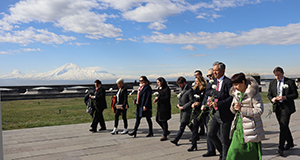
The France-Armenia friendship group of the French National Assembly visited the Armenian Genocide Memorial
27.03.2024
The delegation headed by Anne-Laurence Petel, the head of the France-Armenia friendship group of the French National Assembly, visited the Armenian Genocide Memorial on 27 March, accompanied by Vladimir Vardanyan, the head of the Armenia-France friendship group of the RA NA, and Olivier Decotigny, the extraordinary and plenipotentiary ambassador of France to Armenia.
AGMI Director Edita Gzoyan welcomed the guests. She then accompanied them around the Genocide Memorial complex, presenting the history of its creation. She also narrated the history of the three khachkars placed in Tsitsernakaberd in memory of the Armenians who died in the massacres organized by the government of Azerbaijan in the cities of Sumgait, Kirovabad (Gandzak), and Baku at the end of the 20th century, as well as the stories of the five freedom fighters buried in front of the Memory Wall who died during the Artsakh struggle for survival. She emphasised the connection between the Armenian Genocide and contemporary acts of persecution and violence against Armenians and also referred to the historical and legal aspects of the Artsakh issue, describing Azerbaijan's anti-Armenian actions and propaganda.
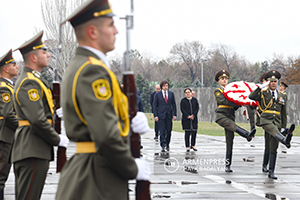
Georgian Prime Minister Irakli Kobakhidze visited the Armenian Genocide Memorial
25.03.2024
The delegation led by Georgian Prime Minister Irakli Kobakhidze visited the Armenian Genocide Memorial on March 25, accompanied by Armenian Deputy Prime Minister Tigran Khachatryan, Deputy Foreign Minister Vahan Kostanyan, Yerevan Mayor Tigran Avinyan, RA Ambassador to Georgia Ashot Smbatyan and Georgian Ambassador to Armenia Giorgi Sharvashidze.
AGMI Director Edita Gzoyan welcomed the guests. She then accompanied them around the Genocide Memorial complex, presenting the history of its creation. Mr. Irakli Kobakhidze laid a wreath at the memorial complex, after which the accompanying guests put flowers at the Eternal Fire and observed a minute’s silence in memory of the innocent martyrs of the Armenian Genocide.
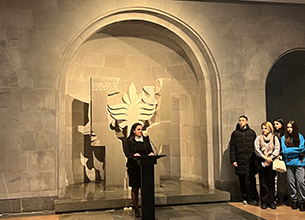
OPENING OF TWO TEMPORARY EXHIBITIONS DEDICATED TO THE TWO MONTHS OF “FRANCOPHONIA” AT THE AGMI
22.03.2024
The first two temporary exhibitions, dedicated to the francophone areas of the world, titled “PRO ARMENIA: FOR YOU ARMENIA” and “THE ARMENIAN GENOCIDE IN FRENCH ARMENIAN ARTISTS’ WORKS” were opened in the AGMI temporary exhibitions’ hall on 21 March 2024.
The opening ceremony was attended by Andrew Turner, Ambassador Extraordinary and Plenipotentiary of Canada to Armenia, Gabriel Chamberjian, President of the "Pyunik" Foundation, Artur Stepanyan, Director of the National Archives of Armenia, Suzanna Khojamiryan, director of the Yeghishe Charents Museum of Literature and Art, Maya Grigoryan, director of the National Academy of Sciences of the Republic of Armenia, professors and students of the French-Armenian Vocational Training Centre and others.

NORA ARISIAN, SYRIAN AMBASSADOR TO THE REPUBLIC OF ARMENIA, VISITS THE AGMI
19.03.2024
Edita Gzoyan, Director of the Armenian Genocide Museum-Institute, received Nora Arisian, Ambassador Extraordinary and Plenipotentiary of the Syrian Arab Republic to Armenia at the AGMI today.
Ms. Arisian congratulated Edita Gzoyan on her election as the director of the Armenian Genocide Museum-Institute, wishing her new successes in fulfilling her high and responsible mission.
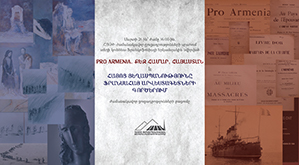
PRESS RELEASE
19.03.2024
Two temporary exhibitions, dedicated to the francophone areas of the world, titled “PRO ARMENIA, FOR YOU ARMENIA” and “THE ARMENIAN GENOCIDE IN FRENCH ARMENIAN ARTISTS’ WORKS” will be opened by the Armenian Genocide Museum-Institute at 16:00, 21 March 2024.
The “PRO ARMENIA, FOR YOU ARMENIA” exhibition presents the humanitarian efforts made by France and the French people directed at saving the Armenian population of the Ottoman Empire.
The “THE ARMENIAN GENOCIDE IN FRENCH ARMENIAN ARTISTS’ WORKS” exhibition presents works by the French Armenian artists Levon Tutundjian, Zareh Moutafian, Jansem (Hovhannes Semerdjian), Asylva (Sylva Arakelian) and Jean-Pierre Seferian. All these artists are survivors of the Armenian genocide or are their descendants and whose works have not remained outside the colours of international pain.
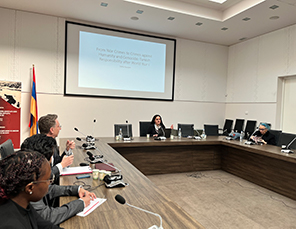
FROM YOUNG TURKS TO NAZIS: THE ORIGINS OF INTERNATIONAL CRIMINAL JUSTICE
13.03.2024
RA NA MPs, public figures, scientists, Sumgait massacre witnesses and ordinary citizens paid their respects to the memory of the Armenians who died in the massacres organised in the Azerbaijan SSR, on February 28, the day of remembrance of the victims of the massacres and protection of the rights of the deported Armenian population. They laid flowers near the khachkars erected in memory of the victims of the Sumgait, Kirovabad (Gandzak) and Baku massacres organised by the Azerbaijani government.
A scientific meeting-discussion was held in the Armenian Genocide Museum-Institute conference hall after the flower-laying ceremony. Edita Gzoyan, AGMI Director, greeted the audience, noting that the crimes committed against Armenians on the initiative of and by permission of the Azerbaijani authorities were another consequence of the state's anti-Armenian policy. She added that the same policy, from the blockade of Artsakh to depopulating it of Armenians, was witnessed in our time.
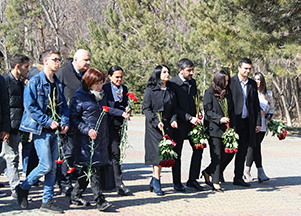
SUMGAYIT POGROM
FEBRUARY 27-29, 1988
29.02.2024
An event titled “From Young Turks to Nazis: The Origins of International Criminal Justice" was held in the Armenian Genocide Museum-Institute’s conference hall on the 12th of March. Speeches were made, during the event, by Edita Gzoyan, leading researcher and director of the Armenian Genocide Museum-Institute Foundation and Christoph Safferling, Professor of Criminal Law, International Criminal Law and International Public Law at the Friedrich-Alexander University of Erlangen-Nuremberg, Germany and Director of the Nuremburg Academy of International Principles.
The speakers presented, in their speeches, the effects the trials against the Young Turks, which started in 1919 and against the Nazis, which began in 1945, had on the formation and development of international criminal justice. The trials against the Young Turks had an important role in terms of recognising the fact and giving a legal assessment of the Armenian Genocide and, what is especially important, the Turks’ own testimonies concerning the Turkish authorities' intention to destroy the Armenians.
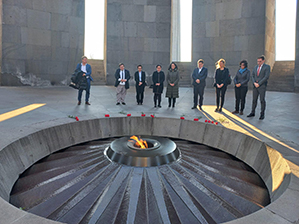
Elisabeth Winkelmeier-Becker, Chairperson of the Legal Affairs Committee of the Federal Republic of Germany’s Bundestag, visited the Armenian Genocide Memorial complex
27.02.2024
Elizabeth Winkelmeier-Becker, chairperson of the Legal Affairs Committee of the Federal Republic of Germany’s Bundestag, led the delegation that visited the Armenian Genocide Memorial complex on February 25.
AGMI Director Edita Gzoyan welcomed the guests. She then accompanied them around the Genocide Memorial complex, presenting the history of its creation. She also narrated the history of the three khachkars placed in Tsitsernakaberd in memory of the Armenians who died in the massacres organized by the government of Azerbaijan in the cities of Sumgait, Kirovabad (Gandzak), and Baku at the end of the 20th century, as well as the stories of the five freedom fighters buried in front of the Memory Wall who died during the Artsakh struggle for survival. She emphasised the connection between the Armenian Genocide and contemporary acts of persecution and violence against Armenians and also referred to the historical and legal aspects of the Artsakh issue, describing Azerbaijan's anti-Armenian actions and propaganda.
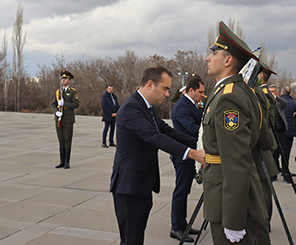
French Minister of Armed Forces Sébastien Lecornu visited the Armenian Genocide Memorial
23.02.2024
The delegation headed by the Minister of Armed Forces of France Sébastien Lecornu, who arrived in Armenia on an official visit, visited the Armenian Genocide Memorial on February 23, accompanied by the Minister of Defense of Armenia Suren Papikyan, Ambassador Extraordinary and Plenipotentiary of Armenia to France Hasmik Tolmajyan and Ambassador Extraordinary and Plenipotentiary of France to Armenia Olivier Decotigny.
AGMI Director Edita Gzoyan welcomed the guests. She then accompanied them round the Genocide Memorial complex, presenting the history of its creation. She also narrated the history of the three khachkars placed in Tsitsernakaberd in memory of the Armenians who died in the massacres organized by the government of Azerbaijan in the cities of Sumgait, Kirovabad (Gandzak), and Baku at the end of the 20th century, as well as the stories of the five freedom fighters buried in front of the Memory Wall who died during the Artsakh struggle for survival. She emphasised the connection between the Armenian Genocide and contemporary acts of persecution and violence against Armenians and also referred to the historical and legal aspects of the Artsakh issue, describing Azerbaijan's anti-Armenian actions and propaganda.
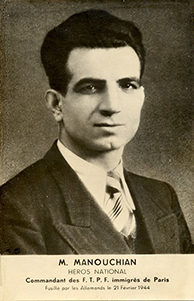
Missak Manouchian: 1906-1944
The Armenian hero of the French resistance
21.02.2024
Following the decree made by French President Emmanuel Macron on June 18, 2023, the remains of Missak Manouchian, a hero of the French resistance and his wife Mélinée, both survivors of the Armenian Genocide, were interred in France's Panthéon on February 21st 2024, commemorating the 80th anniversary of the execution of Manouchian and his comrades. Misak and Mélinée Manushian became the first foreign individuals to be so honoured alongside French national heroes, thus becoming important symbols of friendship between the Armenian and French peoples.
Missak Manouchian (codename Michel Georges) was born in the city of Adıyaman, Kharberd Province of Western Armenia in 1906. His parents were killed during the Armenian Genocide carried out by the Ottoman state. Missak, who was left an orphan with his older brother Karapet (Garabed), were refugees who became inmates of the Armenian General Benevolent Union (AGBU) orphanage in Jounie, Syria. The Armenian orphans in Syria, in accordance with the agreement reached in June 1925, were taken to France, where Missak began his epic journey. He joined the ranks of the French Communist Party in 1934 and began publishing the Armenian-language weekly newspaper "Zangou".
Manouchian was imprisoned and then released during the German occupation of France (1940-1944) during World War II.
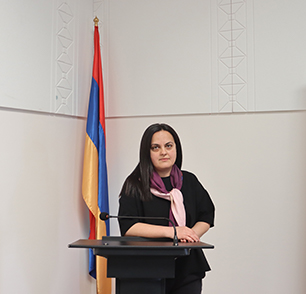
EDITA GZOYAN ELECTED AGMI DIRECTOR
12.02.2024
Edita G. Gzoyan was unanimously elected the new AGMI director by secret ballot during the meeting of the Board of Trustees of the Armenian Genocide Museum – Institute Foundation on February 12, 2024.
She holds a PhD (History), was a senior AGMI researcher between 2013-2018 and a leading researcher and Deputy Scientific Director from 2018 onwards.
Ten of the fifteen members of the Board of Trustees, headed by Dr. Raymond Kévorkian, were present at the meeting. Mrs. Edita Gzoyan presented her vision of AGMI development to the Board members, answered their questions and discussed current Foundation-related issues.
She finally expressed her gratitude for their trust, stating that she takes on the role of AGMI director with a strong sense of responsibility.
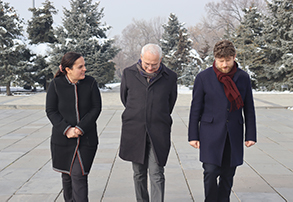
Serge Barcelini, President of the French "Le Souvenir français" Association, visited the Armenian Genocide Memorial complex
03.02.2024
Serge Barcelini, President of the French "Le Souvenir français" Association (established in 1887), headed a delegation visiting the Armenian Genocide Memorial complex, accompanied by the Ambassador Extraordinary and Plenipotentiary of France, Mr. Olivier Decottignies, on February 3, 2024.
Edita Gzoyan, acting director of the Armenian Genocide Museum-Institute, welcomed the guests. She then accompanied them round the Genocide Memorial complex, presenting the history of its creation. She also narrated the history of the three khachkars placed in Tsitsernakaberd in memory of the Armenians who died in the massacres organized by the government of Azerbaijan in the cities of Sumgait, Kirovabad (Gandzak), and Baku at the end of the 20th century, as well as the stories of the five freedom fighters buried in front of the Memory Wall who died during the Artsakh struggle for survival. She emphasised the connection between the Armenian Genocide and contemporary acts of persecution and violence against Armenians and also referred to the historical and legal aspects of the Artsakh issue, describing Azerbaijan's anti-Armenian actions and propaganda.
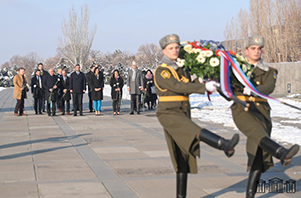
Markéta Pekarová Adamová, President of the Chamber of Deputies of the Czech Republic visited the Armenian Genocide Memorial Complex
31.01.2024
Markéta Pekarová Adamová, President of the Chamber of Deputies of the Parliament of the Czech Republic, visited the Armenian Genocide Memorial complex, accompanied by Ruben Rubinyan, Vice-president of the National Assembly of Armenia, and Arthur Hovhannisyan, head of the Armenia-Czech Friendship Group of the National Assembly of Armenia on January 31, 2024.
Edita Gzoyan, acting director of the Armenian Genocide Museum-Institute, welcomed the guests. She then accompanied them to the Genocide Memorial complex, presenting the history of its creation.
Mrs. Markéta Pekarová Adamová laid flowers at the Eternal Fire and observed a minute’s silence in memory of the innocent martyrs of the Armenian Genocide.
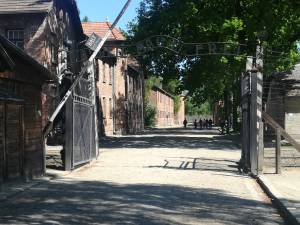
Auschwitz (Oświęcim), a symbol of the Holocaust:
January 27 is International Remembrance Day of the Victims of the Holocaust
27.01.2024
Soviet Red Army troops liberated Auschwitz concentration camp and its 7,000 surviving inmates on January 27, 1945. This date was chosen as International Holocaust Remembrance Day to commemorate the victims of the Holocaust.
Death camps
The use of concentration and death camps is one of the characteristic features of the Holocaust. Hundreds of camps were established in Europe, but six of them were particularly deadly: Chełmno, Bełżec, Sobibór, Treblinka, Majdanek, and Auschwitz (Oświęcim).
Auschwitz is of particular importance among these. Of course, more people were killed in Bełżec, Sobibór, and Treblinka combined than in Auschwitz itself. But Auschwitz was larger in size, in administrative structure and staff and in the symbolic meaning it holds for the Holocaust.
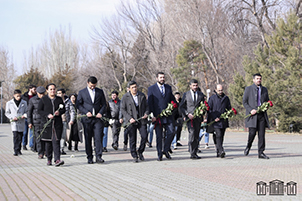
THE BAKU MASSACRES
JANUARY 13-19, 1990
19.01.2024
A group of Armenian National Assembly deputies visited Tsitsernakaberd to pay tribute to the victims of the 1990 Baku pogroms. They laid flowers at the khachkar erected in memory of the victims of those massacres organised by the Azerbaijani government.
Out of the 1.7 million residents of Baku, capital of Soviet Azerbaijan, over 200,000 were Armenians. It is noteworthy that, since the beginning of the Karabakh movement, the issue of their safety and future has been linked to the Karabakh conflict by both the Azerbaijani and the top Soviet leadership. Mikhail Gorbachev, General Secretary of the Central Committee of the Communist Party of the Soviet Union, during a meeting that took place on February 25, 1988, put the question to Zori Balayan and Silva Kaputikyan, saying, "Have you considered the fate of the 207,000 Armenians living in Baku?"
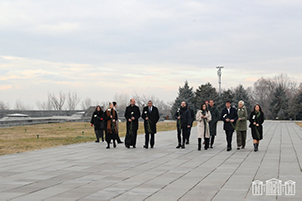
The National Council of Austria delegation visited the Armenian Genocide Memorial complex
17.01.2024
Ewa Ernst-Dziedzic, Member of the National Council of Austria, headed a delegation visiting the Armenian Genocide Memorial complex, accompanied by Shirak Torosyan, the head of the Armenia-Austria Friendship Group of the National Assembly of Armenia, on January 17, 2024.
Lusine Abrahamyan, AGMI Deputy Director for Museum Affairs, welcomed the guests. She then accompanied them round the Genocide Memorial complex, presenting the history of its creation. Emphasising the connection with the Armenian Genocide, Mrs. Lusine Abrahamyan also narrated the history of the three khachkars placed in Tsitsernakaberd in memory of the Armenians who died in the massacres organized by the government of Azerbaijan in the cities of Sumgait, Kirovabad (Gandzak), and Baku at the end of the 20th century, as well as the stories of the five freedom fighters buried in front of the Memory Wall who died during the Artsakh struggle for survival.

Giorgos Gerapetritis, Greek Foreign Minister visited the Armenian Genocide Memorial complex
10.01.2024
Giorgos Gerapetritis, Minister for Foreign Affairs of Greece, led the delegation visiting the Armenian Genocide Memorial Complex, accompanied by Ararat Mirzoyan, Minister for Foreign Affairs of Armenia, on January 10, 2024.
Edita Gzoyan, acting director of the Armenian Genocide Museum-Institute, welcomed the guests. She then accompanied them round the Genocide Memorial complex, presenting the history of its creation.
Dear visitor,
The Armenian Genocide Museum-Institute will be closed on January 6, 2024.
Sincerely,
The Armenian Genocide Museum-Institute Foundation
Dear visitor,
The Armenian Genocide Museum-Institute will be closed from December 31 till January 2, 2024.
Sincerely,
The Armenian Genocide Museum-Institute Foundation
|
News of site |
|
08.01.2020 Update site: The Armenian Genocide Museum-institute
|
|
DONATE |
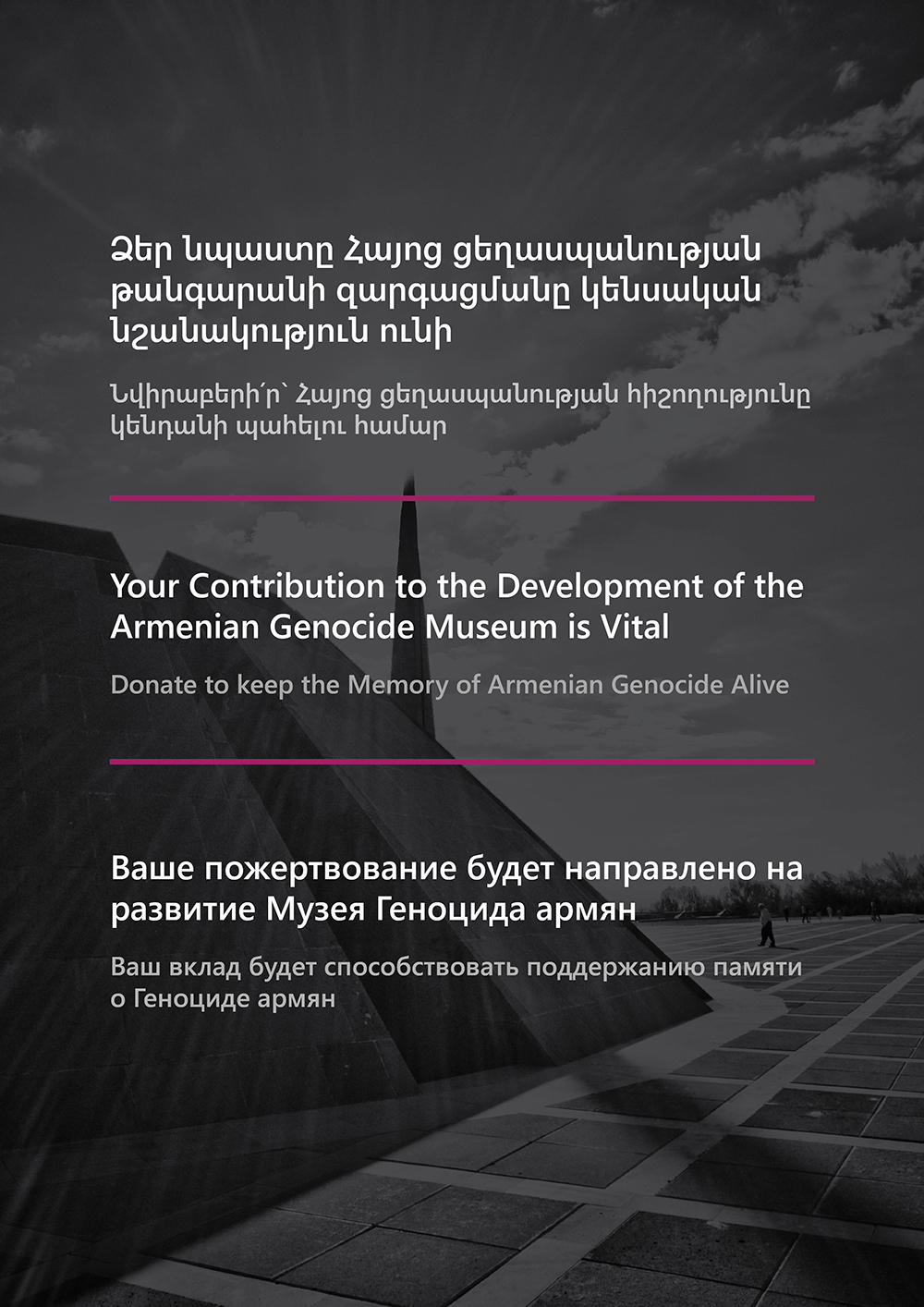
TO KEEP THE MEMORY OF THE ARMENIAN GENOCIDE ALIVE
Special Projects Implemented by the Armenian Genocide Museum-Institute Foundation
|
COPYRIGHT |

|
AGMI BOOKSTORE |

The Armenian Genocide Museum-Institute’s “World of Books”
|
TESTIMONIAL OF ARMENIAN GENOCIDE SURVIVORS |
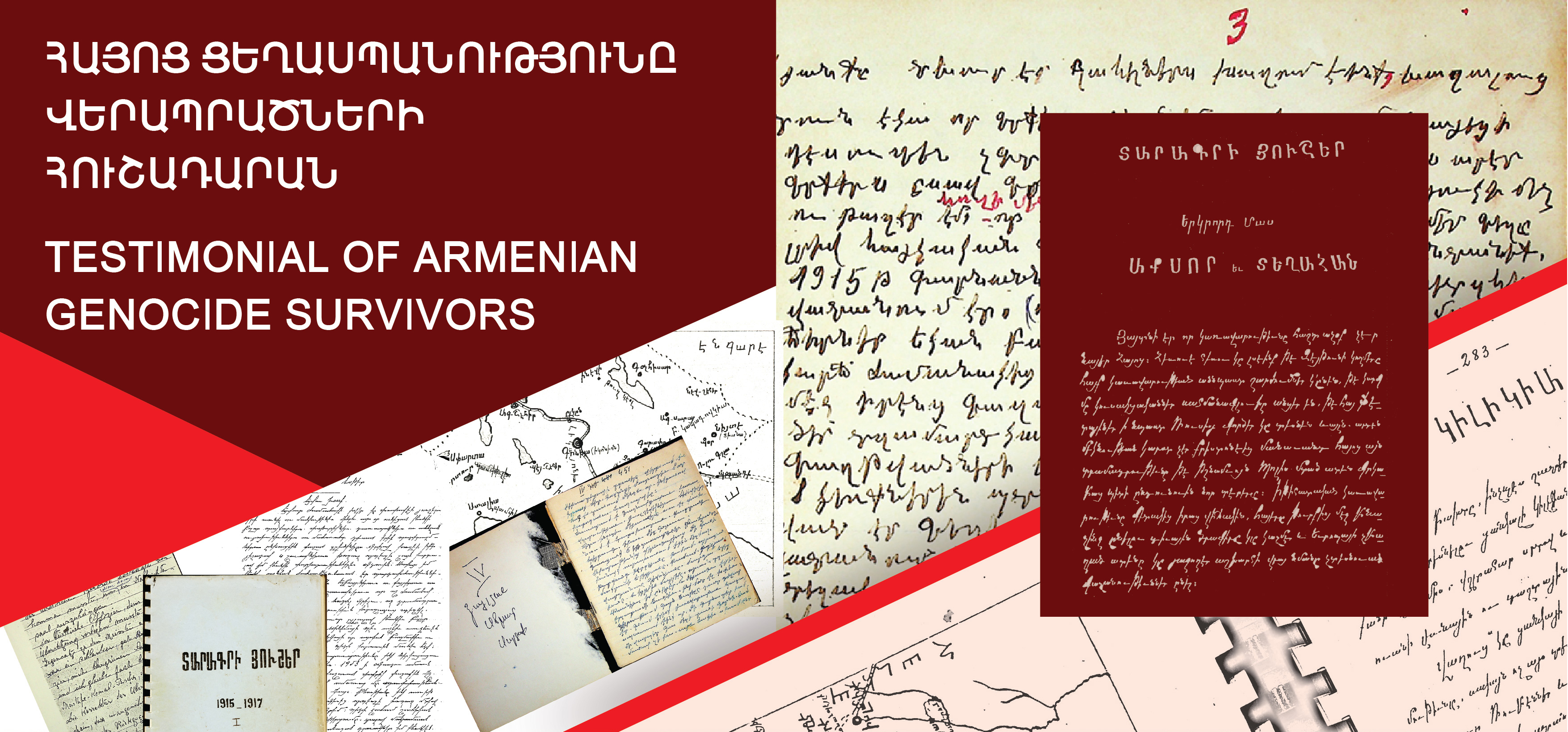
THE AGMI COLLECTION OF UNPUBLISHED MEMOIRS
|
ONLINE EXHIBITION |

SELF-DEFENSE IN CILICIA DURING THE ARMENIAN GENOCIDE
DEDICATED TO THE CENTENNIAL OF THE SELF-DEFENSE BATTLES OF MARASH, HADJIN, AINTAB
|
LEMKIN SCHOLARSHIP |

AGMI ANNOUNCES 2022
LEMKIN SCHOLARSHIP FOR FOREIGN STUDENTS
|
TRANSFER YOUR MEMORY |
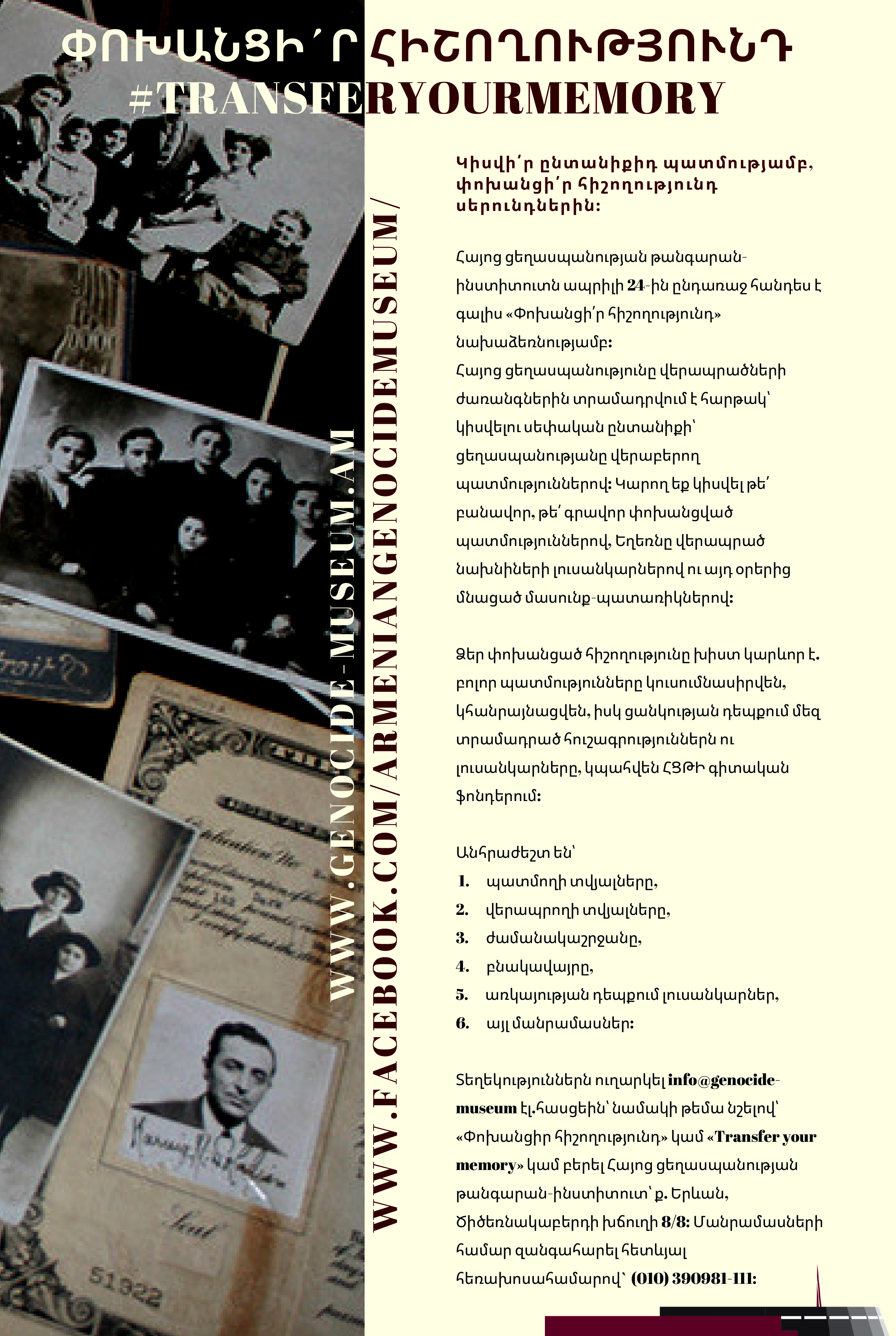
Share your family story,
Transfer your memory to generations.
On the eve of April 24, the Armenian Genocide Museum-Institute undertakes an initiative “transfer your memory”.
|
|



